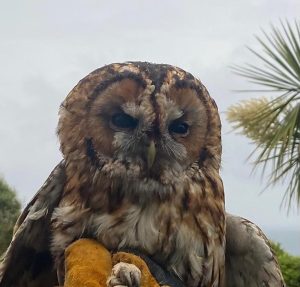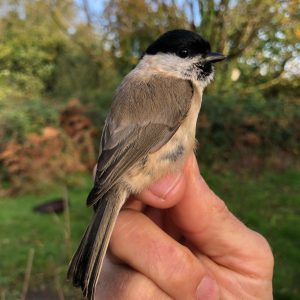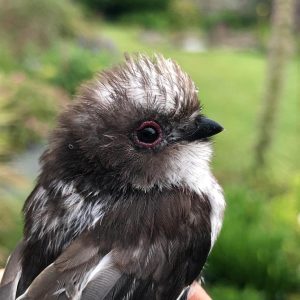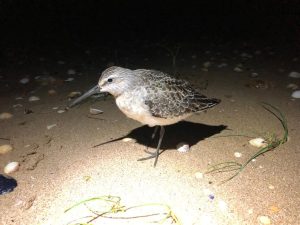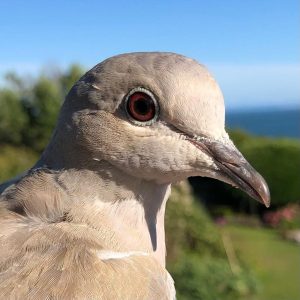Overview of Ringing in 2022
This article provides a summary of our activities in 2022. During the year we continued to contribute critical population data to the British Trust for Ornithology’s (BTO) flagship Constant Effort Site (CES) and Recapture of Adults for Survival (RAS) schemes. Inputs to these projects were led by Heather Coats, Wayne Morris and Richard Dann, with support provided by many of the Group on the pied flycatcher and dipper schemes (particularly Colin Baker with regard to the latter). Dr Miguel Lurgi also commenced an academically-led study looking at aspects of rock pipit ecology and population dynamics.
Training was delivered throughout the year, particularly at Oxwich Marsh, where the largest numbers of birds were captured. This included the Welsh Ringing Course, which had been affected by Covid restrictions during the two previous years (leading to its complete cancellation in 2020). Several group members were recommended for permit upgrade following external assessment, as were several visiting ringers who attended the course.
While biosecurity considerations have been paramount since the Covid pandemic, new controls recommended by BTO to avoid the incidental transmission of HPAI (avian influenza) were also implemented in the final quarter of 2022. These will continue to be applied for the foreseeable future.
Cwm Clydach Pied Flycatcher RAS Project
Our long-running RAS project at Cwm Clydach in the Swansea Valley was registered in 1998, although ringing of pied flycatchers has taken place at the site since 1986. During this time we have provided data that has helped researchers at Cardiff University understand and track the decline of the species in lowland South Wales.
Numbers of occupied boxes plateaued in 2022; 16 nests reached the egg stage, and 12 were ultimately productive, fledging a total of 56 young. Eighteen adults were trapped of which 11 were re-traps from previous years. Productivity compared unfavourably with 2021 when 16 occupied boxes (of which 15 had a successful outcome) fledged 79 young.
Two males which had been ringed as nestlings in 2017 were recaptured. Evidence of a male mating with two females was recorded (as the bird was captured emerging from two boxes with nests on either side of the River Clydach). Both broods (of four and six young) fledged successfully. It is unclear whether the male provisioned the young from both nests.
Gwernffrwd Dinas Pied Flycatcher RAS Project
Several Gower Ringing Group members also contribute to the pied flycatcher RAS at RSPB Gwernffrwd Dinas (under the aegis of the Fledgemore Ringing and Nest Recording Group).
The RAS was registered in 2021 although monitoring pied flycatchers across the reserve has been undertaken for decades. The reserve is large with several sub-sites containing over 650 nest boxes and provides an excellent opportunity for group members to gain experience with cavity-nesting species. Three Gower Ringing Group members gained this endorsement in 2022.
In 2022, 66% of the reserve was monitored; 135 boxes were occupied by pied flycatchers, and of these 113 successfully produced a total of 645 fledglings. 206 adults were trapped of which 96 we retraps from previous seasons. This marked an ‘improvement’ on 2021 where 202 captured adults resulted in 70 retraps. This can partially be explained by the pandemic that affected 2020 where no birds were ringed.
In contrast to previous seasons, all retrapped birds were originally ringed on the reserve. This is not particularly unusual as the species is typically site faithful, though we have had birds from elsewhere in Carmarthenshire, and a female that previously bred in Devon.
Dipper RAS Project
The dipper RAS covering water courses in Bridgend, Neath-Port Talbot and Rhondda Cynon Taf continued. A total of 21 new adults, 17 recaptured adults and 124 pulli were ringed.
Over fifty nests were monitored in total, with fewer than ten completing two breeding attempts. Second brood clutches were smaller and less productive in terms of young fledged than the first broods. The team erected over thirty nest boxes over the preceding winter, and were pleased to note a good proportion in use. It was clear that boxes facing downstream were preferred by birds.
A more detailed summary is here: https://www.gowerbirds.org.uk/dipper-breeding-season-2022/
Southgate Jackdaw RAS project
The newest group RAS project, on jackdaws at Southgate. near Pennard, Gower, commenced in 2022. Following the receipt of colour rings, 39 juvenile and 25 new adult birds were BTO ringed and colour darvic ringed, and an additional five recaptured birds from the previous year darvic ringed. It was good to see sightings of these birds starting to be reported during the year. The BTO has estimated a local breeding population of 200 pairs based on the data.
Wildfowl and Wetlands Trust CES
This was the 21st year of the CES project at WWT Llanelli. Over the course of 12 visits, completed between 30 April and 25 August, 342 birds were captured of which 313 were ringed and the remainder recaptures.
Notable results included an adult male kingfisher caught on 30 April, and a male blackcap ringed as a second calendar year bird in Spring 2016 and re-captured on 30 April.
Garden CES, Crynant (Dulais Valley)
The CES began in 2020 during the lockdown period. A total of 12 visits were completed between 28 April and 21 August, and a total of 733 birds captured (706 of these being new birds). This was the highest total to date. The overall catch was dominated by siskin and (to a more limited extent) lesser redpoll; ten of the latter ringed on 21 May was a good single visit capture for the Group. Forty lesser redpoll were captured overall.
The first juvenile lesser redpoll was caught on 21 June and the first juvenile siskins on 12 May. The only significant re-capture was a male nuthatch ringed on 26 April 2018 and re-trapped on 21 May 2022.
Rock Pipit Population Study
The British Ecological Society funded study of rock pipit, being run by Dr Miguel Lurgi, started off strongly. Permissions were gained from various coastal landowners to target the species at locations between Gower and the Vale of Glamorgan. Forty birds were colour-ringed over the season, with ‘by-catch’ including wheatear and stonechat. As the study enters its second year we hope to see interesting results concerning site and pair fidelity emerge.
Species Totals and Notable Captures
It was a good year in terms of numbers of birds captured and the range of species processed. Numbers of each species processed (including newly-ringed and recaptured birds) in 2022 are presented in the table below.
Table 1. Unique Birds Processed by Gower Ringing Group in 2022
| Unique Birds Processed in 2022 | |||
| Barn Owl | 2 | Marsh Tit | 5 |
| Bar-tailed Godwit | 1 | Meadow Pipit | 22 |
| Blackbird | 243 | Mistle Thrush | 2 |
| Blackcap | 484 | Nightjar | 1 |
| Blue Tit | 764 | Nuthatch | 46 |
| Brambling | 10 | Pallas’s Warbler | 1 |
| Bullfinch | 89 | Peregrine | 1 |
| Buzzard | 6 | Pied Flycatcher | 335 |
| Carrion Crow | 2 | Pied/White Wagtail | 48 |
| Cetti’s Warbler | 51 | Redstart | 28 |
| Chaffinch | 197 | Redwing | 96 |
| Chiffchaff | 325 | Reed Bunting | 42 |
| Coal Tit | 117 | Reed Warbler | 248 |
| Collared Dove | 35 | Ringed Plover | 1 |
| Curlew Sandpiper | 3 | Robin | 313 |
| Dipper | 165 | Rock Pipit | 40 |
| Dunlin | 76 | Rook | 49 |
| Dunnock | 269 | Sand Martin | 21 |
| Firecrest | 20 | Sanderling | 1 |
| Garden Warbler | 15 | Sedge Warbler | 126 |
| Goldcrest | 184 | Siskin | 749 |
| Goldfinch | 674 | Skylark | 1 |
| Grasshopper Warbler | 22 | Snipe | 27 |
| Great Spotted Woodpecker | 29 | Song Thrush | 50 |
| Great Tit | 371 | Sparrowhawk | 3 |
| Green Woodpecker | 1 | Starling | 503 |
| Greenfinch | 182 | Stonechat | 20 |
| Grey Plover | 1 | Swallow | 754 |
| Grey Wagtail | 26 | Tawny Owl | 4 |
| Herring Gull | 4 | Tree Pipit | 22 |
| House Martin | 5 | Treecreeper | 18 |
| House Sparrow | 601 | Turnstone | 1 |
| Jack Snipe | 3 | Water Pipit | 1 |
| Jackdaw | 82 | Wheatear | 4 |
| Jay | 6 | Whinchat | 1 |
| Kingfisher | 4 | Whitethroat | 51 |
| Lesser Redpoll | 45 | Willow Warbler | 141 |
| Lesser Whitethroat | 5 | Wood Warbler | 22 |
| Linnet | 11 | Woodcock | 11 |
| Long-tailed Tit | 188 | Woodpigeon | 23 |
| Magpie | 26 | Wren | 142 |
| Total | 9319 | ||
During 2022 9,319 birds of 82 species were captured (9,455 birds of 91 species in 2021).
The more novel species captured in Ringing Group terms during 2022 were:
- Bar-tailed godwit and grey plover captured during the Welsh Ringing Course. Both were the first of these species to be processed by the Group. The supporting cast included 3 curlew sandpiper, 76 dunlin, a turnstone and a sanderling.
- A Pallas’s warbler captured by Richard Dann in his coastal garden on 25 October. The capture coincided with an influx of the species nationally. The bird was carrying some fat (score 3 using the British Working Group scoring method). Another first for the group.
Notable year totals were for the following:
- Firecrest. Following a blank year in 2021 (the first since 2013), we had our largest annual capture of the species to date in 2022. Bird were initially captured in late September, with the last individual caught in December. They were captured at a number of our sites, with Oxwich (5), Southgate (2) and High Pennard (3) all contributing, but most (10) being captured in Langland. The latter site is a small garden in which one net is erected. It backs onto an area of remnant hedge that runs between mature gardens and links to coastal woodland in which sycamore and holm oak are prominent. The early dates on which we started to catch firecrest are interesting, as this suggests they could be dispersing birds from the expanding English and established Welsh breeding populations as opposed to immigrants.
- Siskin, blackcap, grasshopper warbler and barn swallow. Various sites contributed to the very good numbers of the former two species, while the latter two were almost exclusively captured at Oxwich.
- Collared dove, rook, magpie, house sparrow, starling and jackdaw. These birds were predominantly captured in Richard Dann’s coastal garden at Southgate. The number of all of these species are significant in terms of typical Welsh ringing totals.
A nightjar was caught at Oxwich for the second successive year, again in August. While we tend to capture birds in typical commercial plantation habitats in Neath Port Talbot, this may reflect a return of the species to breeding on Gower (churring birds have been recorded on the commons over the last few years). Equally, however, it could be a dispersing juvenile from elsewhere.
It was a second successive year without a yellow-browed warbler being captured, and there were no eastern race (tristis / Siberian) chiffchaffs captured either (following two in 2021). Both have been a feature of the autumn catch in previous years.
Controls
Controls are birds ringed elsewhere and recovered by the Group (or refer to birds we have ringed that are subsequently caught elsewhere). In 2022 the more notable were:
- A woodcock ringed at Blackhills, Upper Killay in March 2019 and shot at Lekalovo, Okulovskiy District, Novgorod Oblast, Russia. some 2,489 km to the east north-east in April 2022. A sad end, but interesting to see how far some of our birds are going to / coming from their breeding grounds.
- A rock pipit ringed on the Burry Inlet at Penclacwydd in November 2021 and recaptured at Tarevika, Vest-Agder, Norway, some 990 km to the north-east in September 2022.
- Late news of a goldfinch ringed at Southgate in April 2021 and controlled at Olonne sur mer les Biltieres, Sables-D’Olonne, Vendée, France in December 2021.
- Pied flycatchers ringed in Devon (Piles Copse) in 2020 and controlled breeding at Cwm Llechart in May 2022, and a pulli we ringed at Cwm Clydach in June 2016 controlled breeding at Botton Mill, Lancashire in May 2022.
- A Portuguese ringed sedge warbler (August 2021) controlled by Richard Dann in his Southgate garden in August 2022. We also saw two of our Oxwich-ringed birds controlled on passage at different sites on the Atlantic coast of France.
- A reed warbler ringed at Donges, France in August 2020 and recaptured in the Oxwich reedbed in August 2022. The bird was a female (based on its brood patch), but it was captured too late in the season to confirm it was breeding on site. Another of our reed warblers, ringed at Southgate on 12 August, was controlled at Nanjizal, Cornwall a week later.
- Two long-tailed tits ringed together at Kenfig in October 2022 and controlled together at Langland, Gower in November 2022. A straight line movement of approximately 20 km, albeit it is unlikely these birds moved over Swansea Bay. Interesting controls of a fairly sedentary species.
- A dunlin ringed at Berges Island, Whiteford in October 2021 and controlled at Friskney New Marsh, Lincolnshire in mid-September 2022. Notable as we haven’t had many of our dunlin controlled previously.
- A dunnock that apparently moved from Stocksfield, Northumberland to High Pennard, Gower between October 2019 and February 2022; always difficult to rule out a misread, but interesting if accurate. A Devon-ringed dunnock that had hopped over the channel to be controlled in the Oxwich reedbed between 2021 and 2022 seemed a more typical mover.
- Other nice records were a barn swallow ringed on autumn passage on Skokholm Island, Pembrokeshire in September 2021 and caught in the Oxwich roost in August 2022, one of our Oxwich-ringed swallows controlled on Alderney (Channel Islands), a lesser redpoll initially captured in Ceredigion in March 2022 and recaptured at Crynant in the Dulais Valley in June 2022, and our second spring-ringed Oxwich goldfinch to Lundy.
As always, however, while these movements are of interest, much of the more valuable data the Group records and submits to the BTO is less ‘sexy’ and concerns timing of breeding, extent of moult and various biometric information.
Aged Birds
Some of our more notable older birds recaptured during the year (all from Oxwich) were:
- A song thrush recaptured in May 2022, 6 years, 44 weeks and 1 day after initial ringing. It is a female, and breeds on the marsh. It has been captured 13 times, and processed by 12 different ringers, since it was initially ringed by Keith Vaughton on 07 March 2015.
- A Cetti’s warbler recaptured on 17 September 2022, 5 years, 39 weeks and 1 day after it was ringed. This bird is also a female and breeds on the marsh.
- A male siskin ringed as a youngster on 03 July 2017 and recaptured on 27 August 2022, some 5 years and just over 1 month later.
Other senior citizens were a five year old goldfinch, a five year old great tit and a six year old blue tit.
Group News
Colin Baker, Richard Dann and Jo Conway were all independently assessed for their A Permits during the year. All were recommended for upgrade and have received their permits following further assessment by the BTO.
Acknowledgements
We are extremely grateful to the Gower Society for providing an eighth year of grant funding for ringing at Oxwich in 2022. Without this support we would need to scale back our operations, including our training.
Thanks to Nick Edwards and Ed Tucker (of Natural Resources Wales), who manage the marsh. NRW have been consistently supportive of our efforts since we began ringing in 2013, and we are very grateful for their continued backing. Thanks are also due to Martin Hughes, Chris Jones of the Teifi Ringing Group, and Justin Walker (BTO, Thetford) for their help as independent trainers and assessors during the Ringing Course in September 2021.
Thanks also to Richard Dobbins, Wendy James and others from Teifi Ringing Group who facilitated many of our number going to Skokholm during 2022. The experience gained ringing seabirds, using Heligoland traps and just generally ringing in a different environment was hugely helpful and very enjoyable, and the island staff were very welcoming.
Finally, thanks to members of the Gower Ringing Group who have contributed to the totals, managed data, attended sessions regularly over the course of the year or who contributed to the course we ran in the autumn, in particular: Heather Coats, Cedwyn Davies, Keith Vaughton, Wayne Morris, John Lloyd, Simon Allen (Gower Bird Hospital), Sarah Davies, Ed O’Connor, Joanne Conway, Richard Dann, Bethan Dalton, Alex McCubbin, Amy Schwartz, Dionne Jenkins, Colin Baker, Lucy Rowley, Miguel Lurgi, Tom Wright, Andrew Bevan, Ezra Sherwell, Becky Gibbs, Jasmine Davies, Mel Hill, Ursula Scuderi and Alice Connell.
Photos are below.
Owain Gabb
February 2023.
